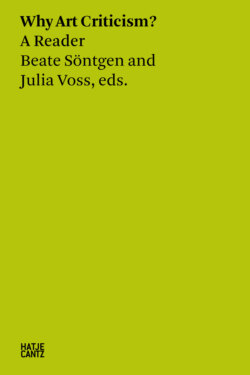Читать книгу Why Art Criticism? A Reader - Группа авторов - Страница 13
ОглавлениеJulius Meier-Graefe
In many ways, Julius Meier-Graefe (1867–1935) was a transgressor of borders. His life and works oscillated between Germany and France, between various arts, media, and materials, and between tradition and avant-garde. The terrain on which his activity was most sustained was art and cultural critique. During the days of the German Empire and the Weimar Republic, he categorized and canonized the increasingly diverse range of artistic streams, using art to seismograph the condition of society and seeking to offer a way of orienting worldviews and aesthetics in times of national rivalries. Friendships with artists like Edvard Munch, Henry van de Velde, and Max Beckmann, fruitful collaborations with collectors, art dealers, and museum directors, and his indefatigable commitment to Art Nouveau, Impressionism, and Neo-impressionism made him an influential agent of modernism.
In the following passage, the critic describes with his typical literary verve his encounter with Édouard Manet’s Le déjeuner sur l’herbe (The Luncheon on the Grass) (1863). This passage is to be found in his powerful Entwicklungsgeschichte der Modernen Kunst (1904) (Modern Art: being a contribution to a new system of aesthetics, 1908); with this, his magnum opus, he attempted in the early twentieth century to raise German readers’ awareness of French modernism. The dense passage gives an impression of his art-critical style.
Before our internal reader’s eye, Meier-Graefe unfolds a scene and in doing so trenchantly highlights the case-by-case nature of the act of criticism. He performs his contemplation of the artwork, showing himself in the process of viewing as a perceiving and reflecting subject. He attempts to comprehend what is capturing his attention and why, entering into a conversation with himself about what he faces. The monologue conducted is not one that digresses from the artifact, with the painting merely providing an occasion for solipsistic digression. The artifact instead challenges a specific experience that it decisively shapes: in order to sensitize to this specificity, Meier-Graefe lets the painting speak—quite literally—in its own voice.
For Meier-Graefe, what the painting expresses is the experience of alienation. But rather than explicitly stating this and describing it in terms of concepts and metalinguistics, Meier-Graefe demonstrates that same mode of sensation and perception in his scenic presentation. He is himself the flaneur who discovers this “outdoor scene” from which he, despite his sympathetic participation, keeps his distance: a distance he requires to be able to reflect on what has been experienced, to appraise it, and ultimately to carry it into a personal, communicable form, into a scene like the one unfurled here.
By showing the work in its effect, description results in value judgments. What Meier-Graefe demonstrates is the painting’s capacity to communicate even the most personal, subjective experiences. Key to this is the ability of the artist (and ultimately also that of the critic mediating the artwork) to mediate participation and distance to each other, to objectify feeling into form.
In this oscillation between distanced reflection and emotional participation, the open-end or “spiral” structure of critique (Michel Foucault) becomes visible—underlined by Meier-Graefe’s remark that Manet’s painting always remains enigmatic to him, though he feels himself to know it “like an intimate friend.” He thus opens a space of negotiation for points of view. More than a means of producing and communicating knowledge, criticism is a medium of persuasion and assumption of perspectives: its “how,” its modes of mediation, are crucial. By narrativizing an object that is before everyone’s eyes, a shared reference point common to all, Meier-Graefe exhibits points of view as points of view. Subjectivity and objectivity thus become discussable as positings and concepts. As a symbolic space, “art” functions as a test tube for mediating the diversity of modern perspectives and, by aiming at tentative agreement, for creating (temporary) emotional communities.
Kunstschriftstellerei—a specific critical practice that in the German-speaking world began around 1900 to build on the French art criticism of the eighteenth and nineteenth centuries and which remained tremendously impactful in the Anglophone world until Clement Greenberg—has played a significant role in shaping the Western canon of modern art. It can be described as a resonance phenomenon in which the negotiation of ego and alterity is central. To conduct this negotiation process, Kunstschriftstellerei has developed a repertoire of persuasive strategies, helping to shape an emotional culture of which it was an indispensable part.
